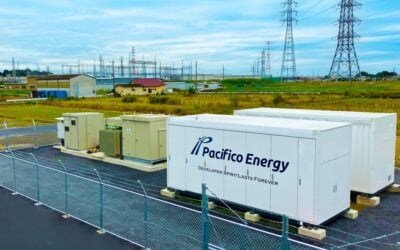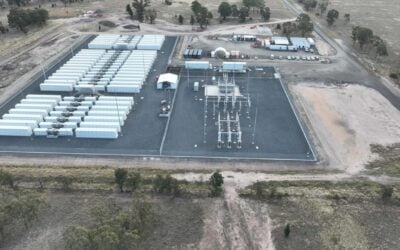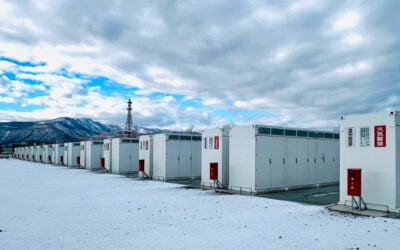Tech investor Peter Thiel. Image: Wikimedia / David Orban.
Involvement from billionaire Peter Thiel in Stem’s Series C indicates a shared belief among investors that “distributed, intelligent storage is going to absolutely revolutionise the electric grid over the coming decades”, the company’s marketing director has said.
Mithril Capital Management, one of Thiel’s investment vehicles, joined big names like European utility RWE and Japanese trading company Mitsui & Co, which had participated in previous funding rounds for Stem. The California-based start-up produces “intelligent” energy storage systems for commercial customers, including the winning of a contract with investor-owned utility Southern California Edison (SCE), to provide 85MW of behind-the-meter storage as part of the utility’s required procurement under the state’s AB2514 mandate rules.
“I think Mithril’s support is a little different to some of the investors we have had in the past, because they’re not a massive energy or technology company,” Stem’s Gabe Schwartz told Energy-Storage.News.
Stem had announced the successful closure of its US$15 million Series C round at the end of May.
Try Premium for just $1
- Full premium access for the first month at only $1
- Converts to an annual rate after 30 days unless cancelled
- Cancel anytime during the trial period
Premium Benefits
- Expert industry analysis and interviews
- Digital access to PV Tech Power journal
- Exclusive event discounts
Or get the full Premium subscription right away
Or continue reading this article for free
“They really back high growth software companies and it really sort of validates Stem’s focus right now, which is continuously developing our software and analytics capabilities.
“We firmly believe that storage is a software-driven business, software is what maximised the value of energy storage systems and that’s really a major piece of where we are going. This extra expertise of Mithril will help to really push that forward.”
Various analysts including IHS’ head of solar research Sam Wilkinson have echoed this belief that software will be a key differentiator for companies in the energy storage space, especially with hardware becoming rapidly commoditised. Software is vital in integrating weather and load forecasting, automating and scheduling tasks and finding the best economic conditions under which storage can operate – for example prioritising higher value functions such as grid-balancing, where such programmes are available.
Stem’s Gabe Schwartz said that Mithril and other major investors are waking up to the future of opportunities as well as present-day ones.
“Without speculating too much as to [our investors’] motivations, Stem sees that this whole notion of distributed, intelligent storage is going to absolutely revolutionise the electric grid over the coming decades. Both in the medium and long term there are some massive growth prospects in this industry.”
Business models for maximum storage utilisation and future grid programmes
Modern energy storage systems are capable of providing several different services at once, known in the industry as “benefit stacking” or “revenue stacking”. Stem’s business model is built around offering businesses the chance to reduce their demand charge costs – the fees levied on commercial and industrial electricity users in the US for their monthly peaks in energy demand.
These costs can constitute as much as 50% of a business’ electricity bills. Schwartz said Stem – which sources batteries from a number of providers – offers businesses this peak shaving service, but is then able to use its proprietary software and control systems to add extra value from grid-balancing programmes where available, stacking revenues and getting maximum utilisation of the battery hardware.
“The batteries, the falling costs and availability and supply chain and other improvements in reliability and things like that have all been fundamentally important to this industry but they’re not enough by themselves,” Schwartz said.
“What really differentiates an energy storage system is going to be what different types of applications it can pursue. We strategically place our systems at commercial organisations where it can benefit and bring down the electricity cost and risk of individual organisations, while at the same time we can coordinate and aggregate systems across our network in order to provide balancing services to the grid. Because of that, those systems can be “busy” more of the time, I guess you could say, than an energy storage system that’s just sitting there to provide backup power, or placed at a home to shift or soak up excess solar energy or something like that. Because we can target at any specific time what is the most valuable use of this battery.”
Schwartz used the example of one of Stem’s customers, Adobe, the software company behind Photoshop, to illustrate his point. According to Schwartz, more than 25% of Fortune 500 companies are under contract or in negotiations with the storage provider on a similar rollout.
“Adobe initially procured a Stem solution to help bring down demand charges, so it was for a single purpose initially.
“We came back to them less than a year later and said: ‘There’s an opportunity to enrol into a smart grid programme, where we can manage excess energy from your battery in order to help support the grid and you can earn extra money’, on top of what was already a payback that was attractive to them. So of course they signed up.”
Stem deploys commercial storage to help businesses reduce peak demand, but its business model allows for future integration of other services. Image: Stem Inc.





